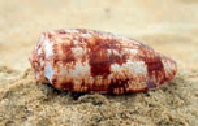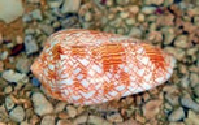Travel Reference
In-Depth Information
Yonaguni horses, the island's indigenous small, free-roaming breed.
The Prety but Deadly Coneshell
Conus is a genus of over 600 species of small to large predatory sea snails found mostly in tropical
seas around the world. Every member of the group is venomous in varying degrees. Cone snails are
carnivorous, and surprisingly aggressive. They have a deadly efecive huning technique that immob-
ilizes their prey using a modified, barbed harpoon (a form of radular tooth) mounted on a long pro-
boscis. The harpoon is a hollow dart loaded from a poison gland of excepionally powerful neurotox-
ins. Small species hunt marine worms and mollusks. Larger cones will catch and kill small fish and oth-
er cones. They can ire their harpoons in any direcion, so handling them, even with gloves on, is dan-
gerous. Their proboscis is long and may reach beyond the gloves and their darts can often penetrate
them. The sing of the smallest cone snails is likened to that of a bee or hornet. The sing of a large
cone may be fatal. It can cause intense pain, swelling, numbness, ingling, vomiting, muscle paralysis,
blurred vision, respiratory failure, even death. Unlike poisonous snake bites, there is no ani-venom
for cone shell bites. The “Geographic” cone (
Conus geographicus
) at let, and the “Texile” cone (
Co-
nus texile
) at right, are two of the most dangerous of all cone snails.


